
eBook - ePub
Kilroy Was There
A GI's War in Photographs
Tony Hillerman
This is a test
Condividi libro
- 80 pagine
- English
- ePUB (disponibile sull'app)
- Disponibile su iOS e Android
eBook - ePub
Kilroy Was There
A GI's War in Photographs
Tony Hillerman
Dettagli del libro
Anteprima del libro
Indice dei contenuti
Citazioni
Informazioni sul libro
When I saw Frank Kessler's collection of photographs I was struck by how different they were from the movie-camera views I see on television. No public relations pictures here, intended to glorify battle and rally support. These were up-close snapshots of the dirty, damp, and disheveled men in the rifle companies and tank units. It was the war as they endured it, as they struggled through it from the beaches of France to the streets of Berlin until they finally won it. —Tony Hillerman
Domande frequenti
Come faccio ad annullare l'abbonamento?
È semplicissimo: basta accedere alla sezione Account nelle Impostazioni e cliccare su "Annulla abbonamento". Dopo la cancellazione, l'abbonamento rimarrà attivo per il periodo rimanente già pagato. Per maggiori informazioni, clicca qui
È possibile scaricare libri? Se sì, come?
Al momento è possibile scaricare tramite l'app tutti i nostri libri ePub mobile-friendly. Anche la maggior parte dei nostri PDF è scaricabile e stiamo lavorando per rendere disponibile quanto prima il download di tutti gli altri file. Per maggiori informazioni, clicca qui
Che differenza c'è tra i piani?
Entrambi i piani ti danno accesso illimitato alla libreria e a tutte le funzionalità di Perlego. Le uniche differenze sono il prezzo e il periodo di abbonamento: con il piano annuale risparmierai circa il 30% rispetto a 12 rate con quello mensile.
Cos'è Perlego?
Perlego è un servizio di abbonamento a testi accademici, che ti permette di accedere a un'intera libreria online a un prezzo inferiore rispetto a quello che pagheresti per acquistare un singolo libro al mese. Con oltre 1 milione di testi suddivisi in più di 1.000 categorie, troverai sicuramente ciò che fa per te! Per maggiori informazioni, clicca qui.
Perlego supporta la sintesi vocale?
Cerca l'icona Sintesi vocale nel prossimo libro che leggerai per verificare se è possibile riprodurre l'audio. Questo strumento permette di leggere il testo a voce alta, evidenziandolo man mano che la lettura procede. Puoi aumentare o diminuire la velocità della sintesi vocale, oppure sospendere la riproduzione. Per maggiori informazioni, clicca qui.
Kilroy Was There è disponibile online in formato PDF/ePub?
Sì, puoi accedere a Kilroy Was There di Tony Hillerman in formato PDF e/o ePub, così come ad altri libri molto apprezzati nelle sezioni relative a History e World War II. Scopri oltre 1 milione di libri disponibili nel nostro catalogo.
Informazioni
Argomento
HistoryCategoria
World War IIWe gray and grizzled veterans sometimes call it “the last good war,” and, indeed, it did offer Kilroys some moments of pride, captured so well by Kessler and others in Normandy street scenes where jubilant residents thank their liberators, children gather around a truck to get chewing gum, and GIs pause a moment to accept a gift of wine in their canteen cups and in pictures of refugee families returning to their ravaged but liberated homes.
But most of us Kilroys missed these joyful celebrations. Villagers wisely took shelter elsewhere when war came down their streets, and duty kept front echelon soldiers moving.
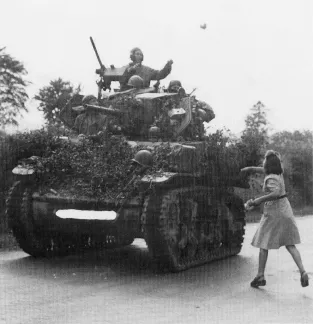
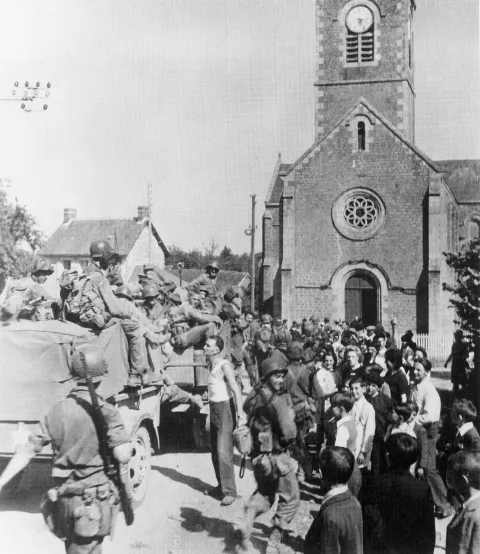
Villagers greet U.S. troops. Summer 1944, northern France
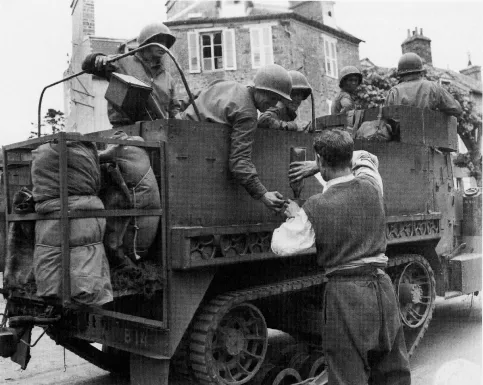
Residents of northern French villages welcome U.S. troops and return to their homes, June–September 1944.
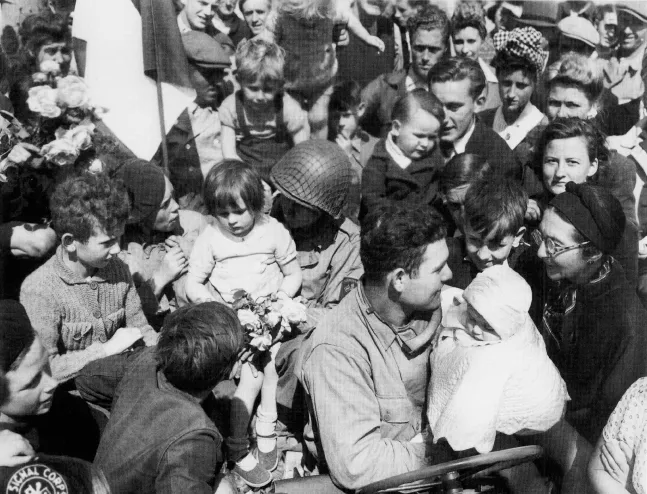
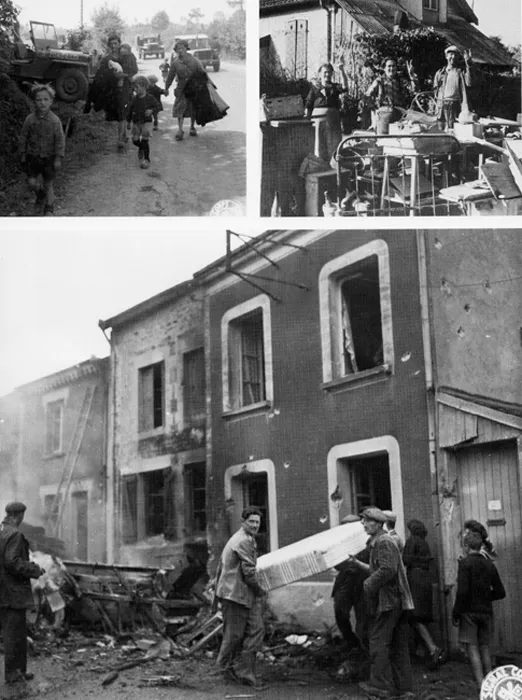

Parisians celebrate their city’s liberation and liberators, August 1944
In the biggest liberation celebration, U.S. Army combat units were held back at the fringes of Paris to allow Charles de Gaulle and his Free French Army the glory of their nation’s salvation. That was okay with us. Rifle squad members by then had done enough street and hedgerow fighting to gladly leave most of the rooting out of German snipers and capture of German prisoners to the home boys. (Besides, being around the generals and the crowd of colonels required getting boots cleaned and “looking like a soldier.”)


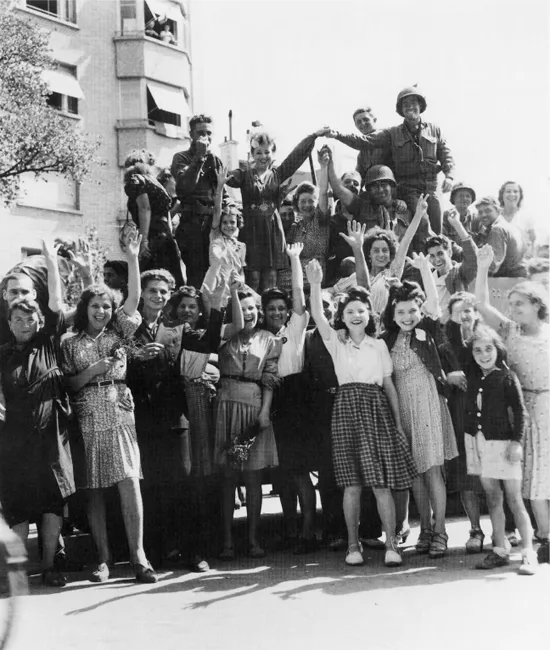


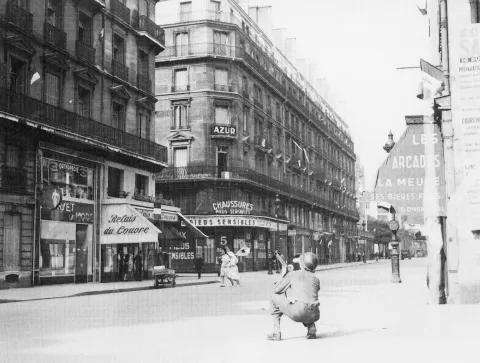
German air power and snipers still posed a threat to Free French and U.S. forces. August 1944, Paris
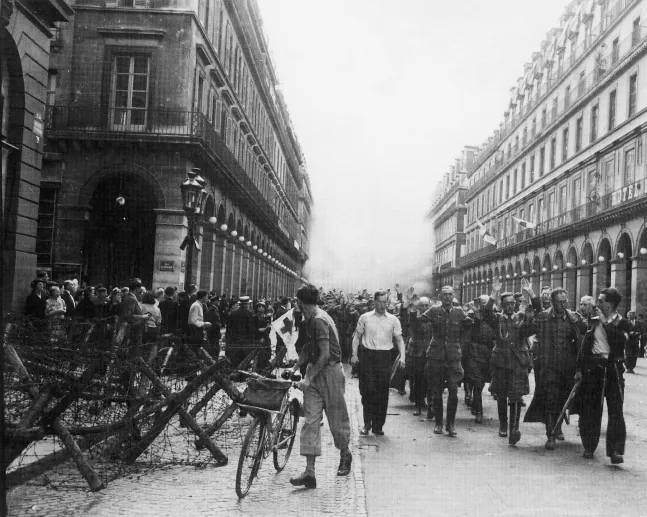
Hands up, a German garrison surrenders. August 1944, Paris
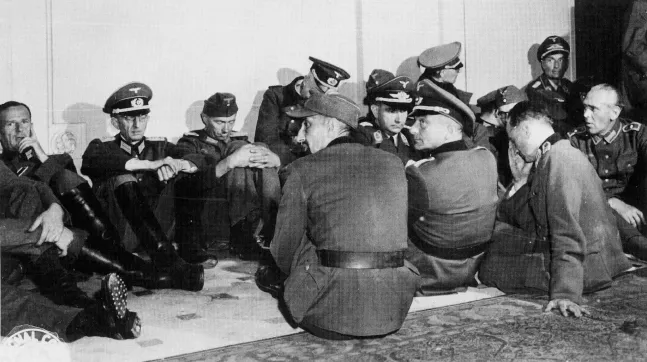
High-ranking German officers await processing in the Hotel Majestic, where they had established headquarters during their occupation. August 1944, Paris
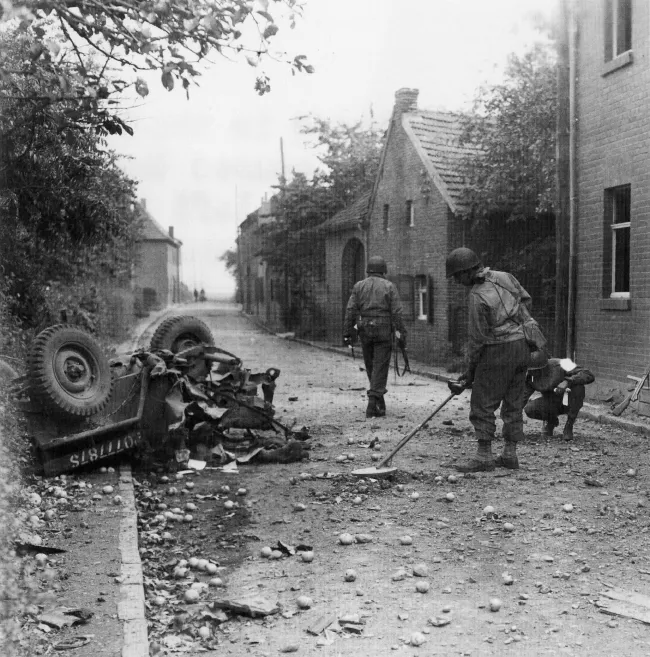
GIs search for more buried mines like the one that blew up this jeep, killing three of their own. October 1944, Germany
Alas, those few joyful memories were offset by the countless grim ones. And one that is difficult for even long-ago soldiers to erase is our first up-close-and-personal encounter with death—no matter the side. The German sprawled on the sidewalk (opposite) still holds the grenade he was poised to throw when the fatal bullet struck him. He would have killed you if he could have, but 60 years later you still remember that he looked a lot like you. Even more indelible are farewells to your own. This Kilroy (opposite), head wound bandaged, is about to be ambulanced back to his battalion’s aid station. If he lives, you may see him again, brought back on a replacement truck to fight some more. Or this may be, if he’s lucky, the “million-dollar wound” that sends him home alive. But the man lying face down (below) is a subject for the Grave Registration team, as is the soldier whose body has been covered with flowers by the French citizens looking on.
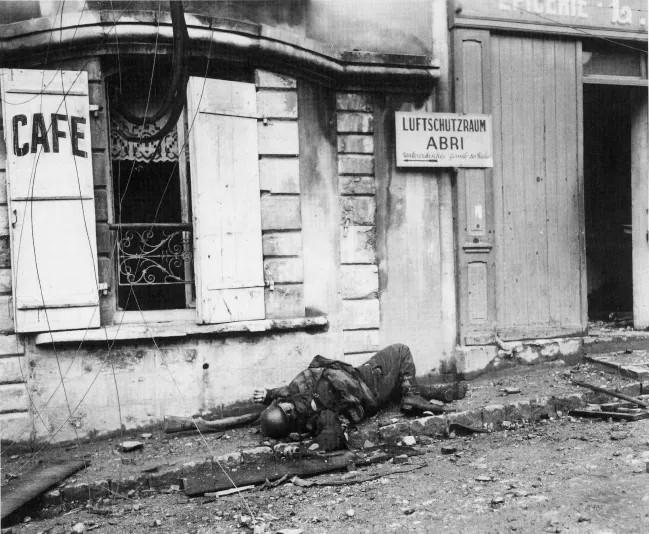

Casualties of war. June 1944, near Cherbourg, France
Medics earned an almost awed respect from their fellow Kilroys. The medics treating the wounded or leading the injured to safety were exactly as vulnerable as the soldiers whose lives they were trying to save. Of the aid men who came for me when I got my million-dollar wound, two were wounded, one fatally.
Injury was not the only relief from combat. The Army did develop rotation systems. For air corpsmen a certain number of combat missions would send them home to train other flight crews. For the infantrymen points were tallied based on months in combat plus extra points (for example, five for a combat wound and five for a “beyond the call of duty” decoration), and there was also a rotation system under which a company could send men back to Paris for a week of R&R, rest and relaxation. Unfortunately, the average infantryman lasted slightly less than six months in combat, winning either a Z-class (Zone of Interior) wound or a body bag before any rotation relief. At the time I was wounded and out of the war, on February 27, 1945, only five men in my Charley Company had yet lasted long enough to benefit from the point rotation system.

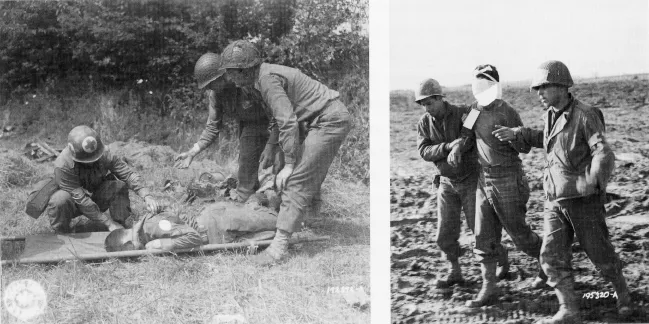
Medics attend to the injured on the front lines: (above)August 1944, France; (below)September 1944, Belgium.
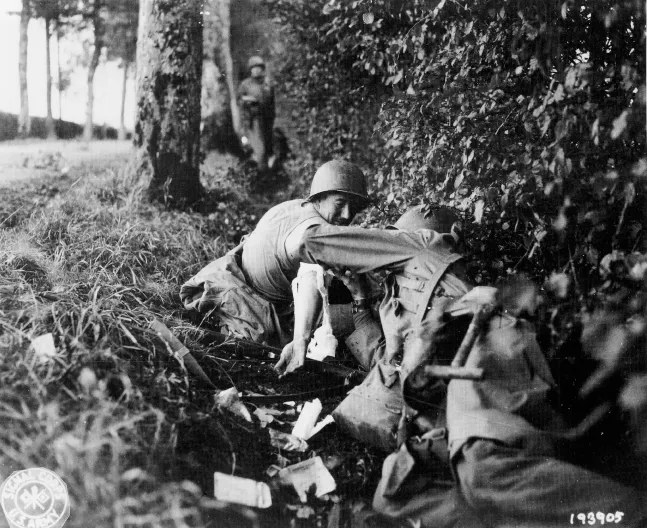
The observation that “war is long days of boredom punctuated by exhilarating moments of fear” is only somewhat exaggerated. For the Kilroys, there was everyday life to be lived, or survived. Some of Kessler’s boys’ most intimate portraits were of us Kilroys going about the mundane.
Illustrated in a photo of troops attending mass is the adage that there are no atheists in foxholes, that at least some of us were believers. (In my own experience, I saw only four chaplains. One was driving through a shattered French village when we flagged him down and asked him to perform services for us in the local church. A second was in a medical clearing station at Saverne. The third we happened on in a snowy Vosges Mountain field. And the fourth I met in the Third General Hospital at Aix en Provence, where I was awaiting a hospital ship to haul me home.)
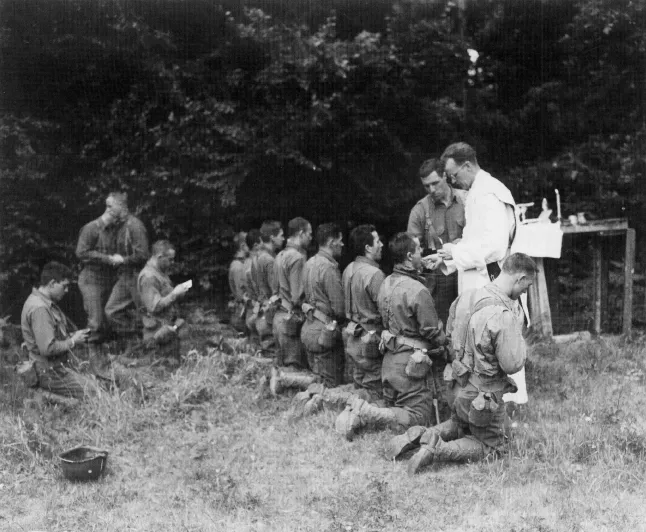
July 1944, France
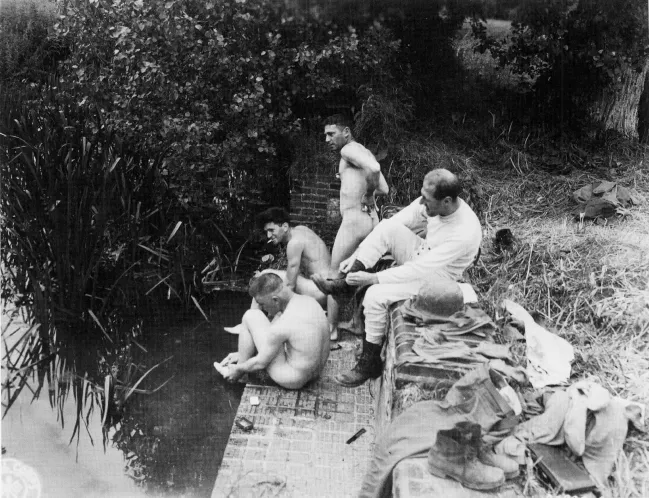
The notion of “cleanliness is next to godliness” did not hold true for combat troops. We washed up where we could—be it a murky stream or a village pump. My Charley Company had only one Army-provided bath from the time we entered combat in September 1944 until March 1945. With the company in Division Reserve, we were treated to a hot shower. In two huge tents erected in a snowy field, we stripped and marched naked (but clutching our boots) into the shower tent, where a gasoline burner heated the water. We scrubbed furiously at the embedded grime with bar soap before rinsing off. We picked up clean socks, shorts, and long johns from a table and reclaimed our dirty uniforms. Beneath the dirty clothes we were clean again—a wonderful feeling!

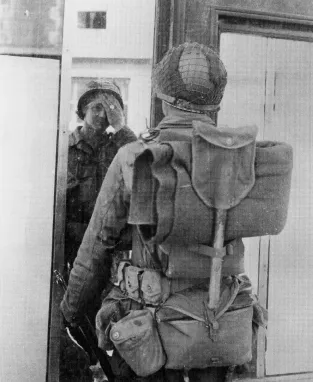
Kilroys were astonished to see themselves in mirrors after life in and out of foxholes. August 1944, France
But it was food, or the lack of it, that consumed most of our thoughts. We were hungry. After all, most of us Kilroys were still in our growing years. We survived mostly on canned C-rations or, even worse, boxed K-rations. Can and box contents varied. Kessler and his men caught us eating what and where ...